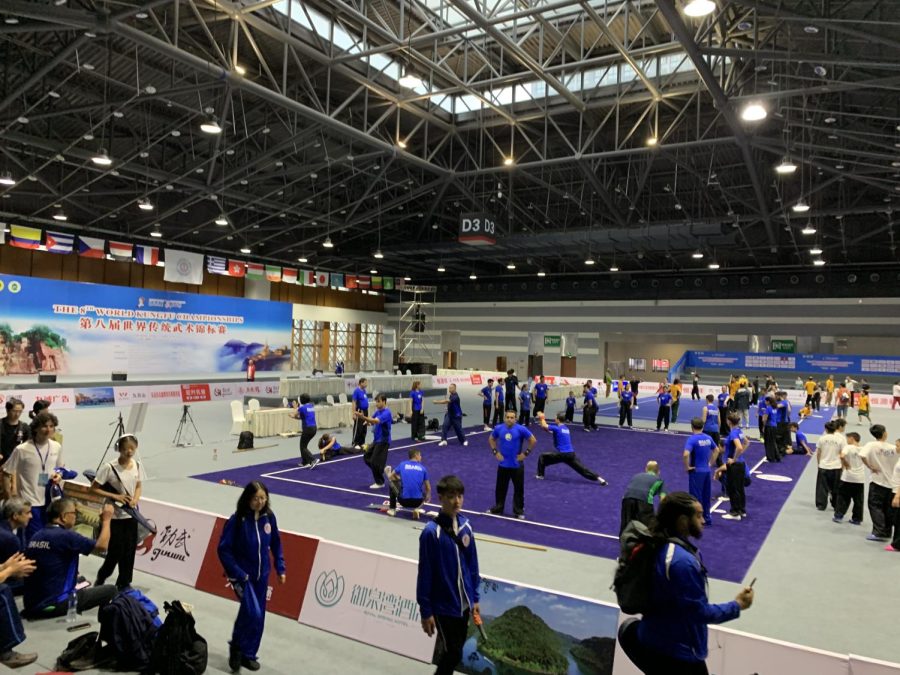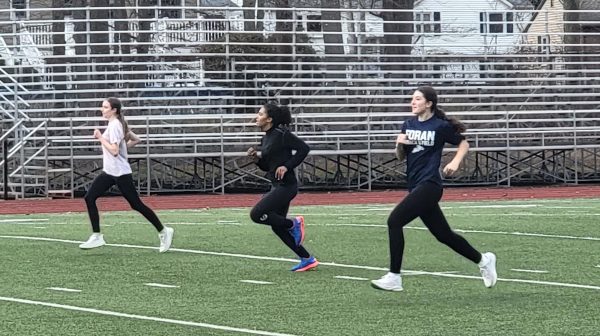Kickin’ It Behind the Scenes: Kung Fu
Competition Day: The USA Wushu Team trains before competing internationally in Emeishan, China.
Kung fu is a type of martial arts that dates back to the fifth century B.C. It is a combination of “soft” and “hard” fighting techniques. The Shaolin Dynasty influenced the history of kung fu by including fighting styles and elements of Buddhism, which eventually developed into a sport.
“Early monks knew that practicing martial arts could improve one’s health but also improve one’s ability to discipline the mind. This combination of mental and physical discipline in one sport was something that the Shaolin monks greatly promoted and something that is still central to martial arts training and practices today,” American Academics of Martial Arts explains.
Most people confuse karate and kung fu. Even though they are both martial arts, karate movements are more straightforward martial arts techniques while kung fu refers to numerous forms of martial arts.
At Wu Dang Kung Fu Academy in Orange, CT, athletes train two to three times a week for two hours. A typical training day starts with warming up. Students stretch out their muscles and run a couple of laps to make sure their body is warm and flexible. Kung fu requires a lot of flexibility because there are lots of movements that allow you to stretch your body in ways that may not be used to. These stretches include straddle splits, regular splits, butterfly stretches, and more.
After stretching is completed, athletes will move onto basics. In kung fu, the basics consist of kicking and punching combinations. This helps to further stretch out muscles and encourage flexibility. Examples of kicking would be straight legged kicks, outside kicks, and inside kicks. They’re self-explanatory in the sense that your leg kicks in that direction to focus on specific muscle groups. These types of kicks are often used in forms.
There are many kinds of jumps that athletes need to learn that are required for specific forms. Some of these include jumping kicks, tornado kick, butterfly, jumping outside kick, etc. “These types of jumps aren’t something that you learn in one day. It requires a lot of training and strength to be able to truly master the movements,” says sophomore Angela He from Amity. He has been doing kung fu for five years and competed internationally in 2019.
Once stretching and warmups have been completed, students will practice their form. “A form is composed of different stances, footwork patterns, blocking movements, evasive actions, striking and kicking techniques,” states Clearwater Kung Fu. There are multiple types of forms such as hand forms, imitation forms (imitating an animal), and weapon forms.
“We typically practice a form that we just learned or a form that we’re preparing to compete in. Due to Covid-19, we haven’t been able to compete in person since 2019, but we have been able to do virtual competitions,” says senior Sherry Li from Monroe. Kung fu consists of a lot of body work in which one needs to allow their body to follow the movement of their weapon. Soft techniques require the body to move flowy or like fluid while hard techniques are sharp movements.
Athletes train hours on end to further their skills in order to be prepared to compete. Competitions are held for athletes around the world, mainly the U.S. The World Kungfu Championships are held every other year, but due to Covid-19, they haven’t held a competition since June 2019. This is an international competition where 50-60 countries come to compete against one another in Emeishan, China, where kung fu originated.
“The competition was an eye-opening experience because it was so different from your typical competition in the U.S and the sport provides you with endless opportunities. Being able to compete but create bonds with people from different countries was so amazing. It almost felt like you were in the Olympics,” He states.
Kung fu is scored similar to a gymnastics scale. Each competitor starts with nine points and for every mistake they make, points are deducted. It’s also based on technique and skill so the harder the movements, the more points one receives. They are split up into categories based on how long someone has been training and the type of form they’re competing in, whether it’s an empty hand form or weapon form. Forms also have time limits which usually range from a minimum of 30 seconds to a max of two minutes. The competition area is a mat normally 20’ by 42’ in which athletes cannot step out of, or else points will be deducted.
Wu Dang Kung Fu Academy’s teacher, Jack Guo states, “Sadly, kung fu isn’t as popular as other types of martial arts but it’s starting to make its way up there. This sport is so diverse with the techniques used and I recommend everyone should learn how to defend themselves because you never know when you’ll need those skills.”
Kung fu isn’t something that someone can learn in a day. It requires a lot of practice to develop and master the skills that are learned. “I’ve been doing martial arts for ten years and I’m nowhere near perfect. It takes time and discipline to be able to truly use those abilities and understand them in the real world,” says Li.
Your donation will support the student journalists of Foran High School. Your contribution will allow us to purchase equipment and cover our annual website hosting costs.

Hi, my name is Tori Matula and I’m a senior at Foran. I’m a content editor and I enjoy writing about any topic. I play volleyball at Foran...







